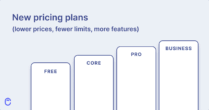If you work in SaaS, the chances are that product demos are a regular part of your work. You might conduct all your demos online or have recently pivoted to online demos due to the ongoing COVID-19 pandemic.
A great SaaS demo should achieve one main goal:
Convince your prospect that your solution will help them achieve their goals or solve their problem.
Fortunately, it’s entirely possible to achieve this online.
To help you, I’ve compiled a list of steps to help you conduct a remote SaaS demo that converts prospects into clients. Let’s get going!
Start with a discovery call
Too many SaaS salespeople make the mistake of diving straight into a demo without doing a discovery call.
If you’re not sure whether this step is really necessary, consider the fact that sales reps that skip the discovery phase are 73% less likely to convert.
A discovery call should achieve the following:
- Decide whether your product is a good fit for this prospect.
- Understand client concerns. What problems are they facing and what outcomes are they looking for?
- Establish rapport.
- Convince the prospect to attend the demo.
A discovery call should take less than 30 minutes, and is one of the most vital steps in your marketing funnel. Considering how much a discovery call can boost your conversion rate, there is absolutely no reason to skip it.
Schedule the SaaS demo
Try to schedule the demo at the end of the discovery call. If the prospect isn’t able to commit to a specific time right away, send an email with suggested slots immediately.
Here are some basic guidelines for scheduling your demo:
- Aim to hold the demo within five business days of the discovery call.
- Keep it short (45 minutes or less).
- The best time of day for a demo is 3 PM to 5 PM.
- Involve all key stakeholders and ensure you’ll be talking to someone with decision-making responsibilities.
- Send the meeting invite and link in plenty of time.
Once you’ve scheduled the demo, it’s time to get to work on making sure it converts.
Create—and stick to—an agenda
“Failing to plan is planning to fail,” as the saying goes. Therefore, going into a meeting without a clear agenda is a big mistake.
Create an agenda in plenty of time and send it to everyone who will be attending the demo for their input.
Here is an example of a SaaS demo agenda that has a good chance of landing a sale:
- Intro (5 minutes): Connect with the prospect and establish trust.
- Set the tone (5 minutes): Summarize the talking points from the discovery call, focusing on the prospect’s pain points and concerns.
- Propose the solution (15 minutes): Demonstrate how your solution will help solve the client’s most significant pain points.
- Q&A (5 minutes): Time for the client to ask any questions.
- Discuss the next steps (5 minutes): Know more about the prospect’s decision-making process, including procurement timelines. Find out what the client needs to decide whether or not to purchase your solution.
Creating an agenda and sticking to it lets everyone know what to expect and ensures you’re all on the same page. It also avoids wasting the prospect’s time.
Prepare for the presentation
While the best sales pitches feel spontaneous, they are actually the result of intense preparation. The worst thing you can do before a SaaS product demo is under-prepare.
Follow these tips to ensure you’re fully prepared:
- Test your equipment and network connection. Always prepare a backup connection option, just in case.
- Build a demo playbook. This should contain product features, success stories, case studies, and value propositions.
- Make sure you have everything you need before you start the call.
- Use relatable sample data. This will help the prospects picture themselves using your solution.
- Prepare for objections. Your prospect will probably be doubtful for most of the demo. Know your solution inside out and have answers to common objections prepared.
- Practice with your colleagues. Rehearsing your demo and collecting feedback will help identify strong points and areas for improvement.
Louis Pasteur once said, “Chance favors the prepared mind.”
Take control of the situation by ensuring you’re adequately prepared, and your product demo will be a breeze.
Personalize, personalize, personalize
If you want to convince the prospect to buy, your demo must be tailored to them. A generic demo simply won’t cut it.
Here are some ways you should personalize your product demo meeting.
Build rapport
According to LinkedIn, trust is the most critical factor that influences a purchase. The more a prospect trusts you, the more likely they are to buy from you. To get them to like your product, you need to get them to like you first.
Therefore, building rapport at the start of the meeting is essential. First impressions are hard to overcome, so ensure you start off on the right foot.
Never jump into sales talk right away. Instead, take a few minutes to make small talk and build a human-to-human connection with them.
Put the prospect at the heart of the story
Story-selling is a highly effective form of marketing. Instead of simply telling the prospect that your product is amazing, you need to tell them a story that shows how it can help them.
Follow these tips to tell your prospective client a compelling story:
- Make your prospect the main character. In other words, put them front and center at all times.
- Paint a vision of a world where your prospect has solved the main problem with which they are struggling. How would that look? Show them how much easier work and life would be if they implemented your solution.
- Sum up how your solution will take them from where they are now to where they want to go.
- Use social proof from clients who have used your product to solve a similar problem.
By getting the prospect emotionally invested in their desired outcome, you allow them to envision precisely how your solution will help them achieve it.
Focus on value
I don’t particularly like the term “product demo.” It conjures up an image of those door-to-door salesmen of old.
This is not what you want your prospect to be thinking of as you demonstrate your product to them!
Your job is to convince the prospective client that they need your solution. The best way to do that? Focus on benefits, not features. In other words, put less emphasis on all the cool things your product can do, and more emphasis on how it can solve this specific prospect’s problems.
Too many sales reps demonstrate the features of their solution without any clear agenda or context. Remember the story we told in the last step, featuring an ideal future where the client’s problem is solved? What you need to do now is show how your solution will help them reach that ideal future state.
So, understand and focus on their main pain points. You do not have to demonstrate every single feature of your solution at this stage. If you try, you’ll likely overwhelm the prospect! Instead, keep your demo centered on the specifics of how it will help them.
Make it a conversation, not a lecture
If you talk at your prospect for an hour, they’ll switch off and won’t take in what you say. Instead, you should ensure that the demo is conversational.
Invite them to have input, to share their thoughts and concerns, and to ask questions. That way, you can respond to them. Being responsive is the best way to show the prospect that you are listening and take their concerns seriously. If you read from a script, they’ll feel as though you don’t care about them and are just looking to make a sale.
It’s a good idea to pause after each main point, allowing the prospect to jump in with any thoughts or questions if they wish.
The CTA and next steps
Congratulations, you’ve completed a successful demo! What next?
Never assume that you’ve sealed the deal until you’ve got a signed contract from the customer. Instead, end your presentation with a clear call to action (CTA).
What do you want the prospect to do next? You might ask them to sign up, try the product for themselves, or set up another meeting.
Close the product demo meeting by discussing the next steps. Assuming the prospect does not decide to purchase immediately, you should understand their decision-making process and timescale.
If possible, schedule a follow-up meeting before you end the call. At the very least, agree to follow up by email on a specified date. You might offer an incentive at this stage, such as a 30-day free trial or a limited-time discount.
Even if the prospect is very interested, you could lose them if you fail to follow up. Therefore, never end a demo call without understanding what you will do next.
Use tech to your advantage
It’s important to invest in the appropriate technology to help you make your demos go as smoothly as possible.
Here are some tools you should consider for high-converting demos:
- A good headset and microphone: Struggling to hear each other will make the call frustrating and put the client off.
- A screen-sharing app: Most video conferencing apps have a built-in screen-sharing function.
- Screen recording: Many conferencing apps have this function, which allows you to record your demo and send the prospect the recording after the meeting. This is helpful if they need a reminder or want to show the demo to other stakeholders in their company.
Wrapping up
A product demo is much more than merely a showcase of your solution’s capabilities. It should take into account the client’s needs, pain points, and business goals, then demonstrate how your product can help them achieve those goals.
Just like in-person product demos, remote SaaS demos should always start with a discovery call. What you learn on this call will influence the agenda of the demo. This should focus on significant pain points, paint a picture of the ideal end-state, demonstrate how the product solves real-life business problems, and end with clarification of the next steps.
A virtual SaaS demo is your opportunity to prove that your product is the solution the prospect is looking for. So start brushing up your online presentation skills now, and you’ll soon start seeing more conversions rolling in.






